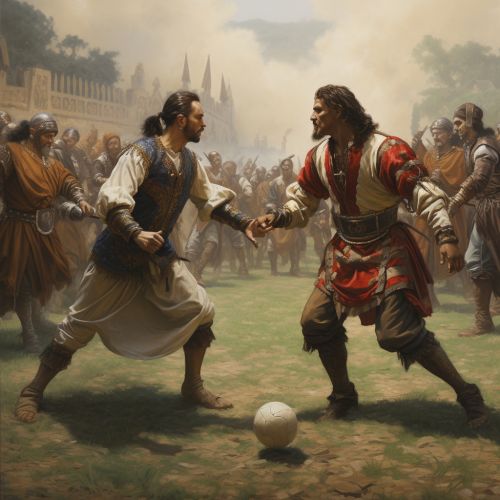Association football
History
Association football, more commonly known as football or soccer, originated in England in the mid-19th century. The first set of rules, known as the Laws of the Game, were established in 1863 by the newly formed Football Association. The sport's history is rich and complex, with roots tracing back to various games played by ancient civilizations.


The sport quickly spread to other parts of the world, with the first international match taking place between Scotland and England in 1872. The World Cup, the sport's premier tournament, was established in 1930 and has been held every four years since, with the exception of 1942 and 1946 due to World War II.
Gameplay
The game is played between two teams of eleven players each, including a goalkeeper. The objective is to score more goals than the opposing team within the 90-minute timeframe. The game is divided into two halves of 45 minutes each, with a 15-minute half-time break.
The field, also known as the pitch, is rectangular and marked with boundary lines. The longer boundary lines are called touchlines, while the shorter ones are goal lines. The pitch also features a halfway line, a centre circle, penalty areas, and goal areas.
The ball used in association football is spherical and made of leather or similar materials. It has a circumference of 68-70 cm and a weight of 410-450 grams.
Rules and Regulations
The Laws of the Game govern the sport of association football. These laws are maintained and updated annually by the International Football Association Board (IFAB). The laws cover all aspects of the game, including the field of play, the ball, the number of players, the players' equipment, the referee, the duration of the match, the start and restart of play, the method of scoring, offside, fouls and misconduct, free kicks, penalty kicks, throw-ins, goal kicks, and corner kicks.
Tactics and Skills
Tactics in association football are widely varied and complex, with teams employing different strategies based on their strengths and the weaknesses of their opponents. These tactics can include different formations, styles of play, and player roles.
Skills in association football are also diverse, with players needing to master a range of technical abilities such as passing, shooting, dribbling, heading, and tackling. Goalkeepers require specialized skills such as shot-stopping, positioning, and distribution.
Competitions
There are numerous competitions in association football at both the club and international level. The most prestigious club competition is the Champions League, organized by the Union of European Football Associations (UEFA). At the international level, the most prestigious competition is the World Cup, organized by the Fédération Internationale de Football Association (FIFA).
